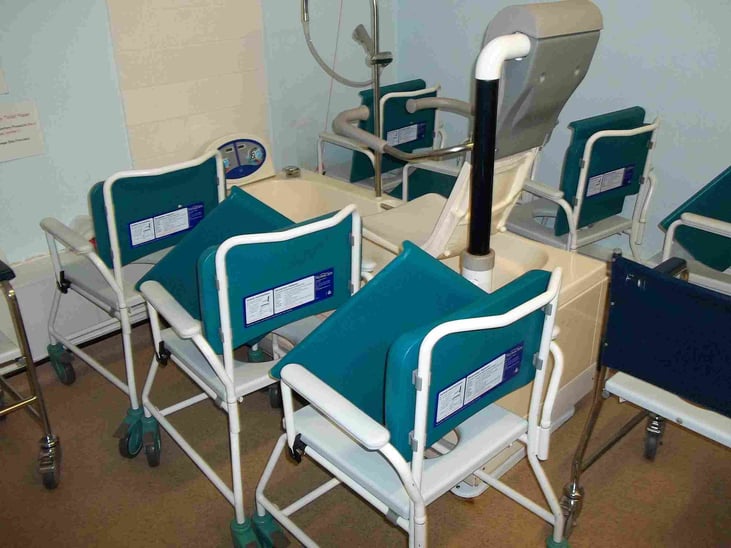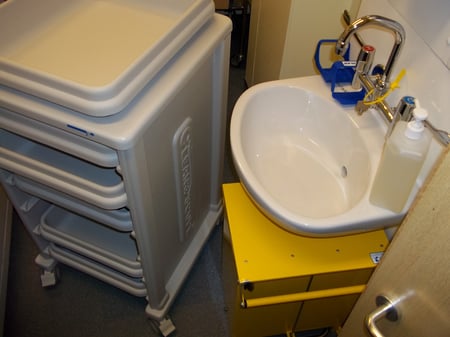The Legionella flushing regime remains one of the key tools in the armoury of any Estates or buildings manager when attempting to minimise potential Legionella bacterial growth and proliferation within their water systems.
The basic premise involves identifying little or temporarily un-used outlets and whilst usage remains something other than regular, attempting to replicate ‘regular’ usage, by running or ‘flushing’ these outlets.
However, the success of such a regime is in no small part dependent upon a clear understanding of what we are trying to achieve, a consistent and straightforward approach to both the task and keeping water safety records and even an appreciation of human nature for what can be tedious undertaking for the flushing team.
So why then, are flushing regimes so important?
There are three factors that determine the likelihood of Legionella bacteria colonising a water system:
- Water temperature: made more difficult in a dirty system where the temperature cannot penetrate sediment build up or where the movement of water is restricted so that hot water cools and cold water warms up; if the water temperature is not controlled or if water is allowed to stagnate then bacteria will find a place to grow.
- Cleanliness: i.e. availability of nutrients and shelter; water distribution systems externally and particularly internally allow entry to and provide shelter to a multitude of nutrients aiding bacterial growth.
- Water age: i.e. the rate of water movement and turnover within a system; even where water turnover is high, bacteria will find a place of shelter amongst sediment and sludge or hide out in pockets of the system that struggle to achieve the required temperature.

Fundamentally, the control of Legionella bacteria will be achieved by considering these three concerns and addressing the host of shortfalls that may be present in the design, installation, maintenance or operational performance of the water system and including the implementation of an appropriate flushing regime.
What will a flushing regime achieve?
Periodic flushing of outlets can be an effective means of achieving a regular changeover of the water contained in the little used outlet and its associated supply pipework. This will then ensure the following:
- There is an introduction of fresh cold water containing residual disinfectant, either from the mains supply [or from a supplementary water treatment system, if fitted];
- There will be regular exposure of hot water pipework to temperatures at which Legionella and other bacteria are discouraged;
- The disturbance of biofilms resident within distribution pipework and fittings, through the shearing action of running water.
On the surface, a flushing regime could be perceived as a simple process put in place to treat an inevitable fluctuation in outlet or facility usage. The process is indeed often quite simple, whereas the successful management is certainly often far from that and can involve a host of stakeholders, the need for a vigilant and flexible approach and crucially a verification process to ascertain if the process is effective.
The Health and Safety Executive’s HSG274 Legionnaires’ Disease: Technical Guidance Part 2 states that any outlet “not used for a period equal to or greater than seven days” should be classed as a little used outlet and that “for high risk populations, e.g. healthcare and care homes, more frequent flushing may be required as indicated by the legionella risk assessment”.
For healthcare premises, the Department of Health’s HTM04-01 Part B: Operational Management also states “water draw-off should form part of the daily cleaning process. The procedure for such practice should be fully documented and covered by written instructions”.
Flushing Regime - The Do’s:
- The precise identification of any and all little used outlets remains critical alongside the identification of those staff who can provide you with the knowledge to locate and maintain these outlets. Estates managers will require the assistance of building/department occupants to identify them and whilst in some cases Estates teams will have the resources to implement a Legionella flushing regime, in others this duty will fall to the building occupants themselves;
- Ensure the Legionella training and competency and subsequent re-training and reiteration for all stakeholders who can influence little used outlet presence and their on-going management. An increase in risk by the uninformed cannot be underestimated;
- Ensure the process for completing the flushing task is straightforward, understood by all and its ongoing review is a part of your organisations water safety framework;
- Water Safety Record keeping requirements must be clear, documented appropriately/controlled and forms should be accessible to all;
- Ensure there is clarity regarding the definition of ‘infrequent use’ – this may vary between applications and will depend not only on frequency and duration of use, but also other risk factors, such as water temperature and the vulnerability of the population. A Legionella flushing regime should be devised as part of your organisations ‘written scheme of precautions’ or ‘water safety plan’;
- Although microbial growth may well be adequately controlled by identifying areas of infrequent use, i.e. those used less than once per week, and flushing them at least weekly (typically twice weekly or as required in healthcare and other high-risk premises). Each outlet should be flushed for long enough to ensure that the entire contents of the outlet and its associated supply pipework has been replenished with fresh water. Water temperature can certainly be a helpful indicator in this respect – by flushing for as long as it takes for the water from the outlet to stabilise at a temperature comparable to the incoming supply;
- Ensure your responsibility structure for management and execution of the flushing programme includes arrangements for holiday cover and absenteeism;
- Ensure there is a flushing task risk assessment and safe method of work formulated, i.e. how to flush outlets safely – the risk between a little used but flushed outlet and an unused outlet may be significant;
- Clarify the process for identifying little used outlets and updating the list of outlets or facilities under review.
Flushing Regime - The Don’ts:
- Where little used outlets are identified, it should first be established if the outlets are surplus to requirements. If no longer required, outlets must be removed rather than flushed – ensuring that all associated supply pipework is taken out and that no live dead-end pipework remains in situ. Prevention or elimination in this regard, is very much better than cure. Where this cannot be achieved a regular legionella flushing regime will be required;
- Once a flushing regime has been implemented, ensure it remains in place and undertaken routinely – intermittent flushing may exacerbate bacterial growth and biofilm development;
- Do not assume that a flushing regime alone will resolve underlying or causal bacterial issues. Flushing will always be part of a wholistic water management approach. Indeed, in larger more complex systems the continual dosing of biocide may also be required in combination, to ensure a water system remains microbiologically safe to use;
- Avoid over-provision of services at the design stage of a project or later on, resulting in reduced frequency of use;
- Avoid unauthorised isolation of water services;
- For longer periods of disuse, it can be acceptable to leave a system filled with water without weekly flushing – though only provided that measures are in place to prevent unauthorised use. Draining down a system unnecessarily may leave residual moisture or pockets of water within the system, potentially created or exacerbated by high humidity, and this may subsequently provide a ‘reservoir for contamination’ or an area for biofilm to develop;
- Where there is large scale lack of outlet/property usage, do not assume a flushing approach comparable to that of only a few intermittently used outlets will be appropriate – guidance is commonly aimed at the latter and in times such as those affected by Covid-19 lockdowns, a much more robust approach to water system management may be required.
The risk mitigation principles behind flushing and ensuring that water is wholesome and microbiologically safe are very straightforward but ongoing compliance with these principles takes time, consideration and buy-in from a number of key stakeholders. These include Estates, Health and Safety, Microbiology and Infection Control Teams, Projects and Design and not least Facilities.
Feel free to reach out if you have any questions about this blog or if you would like to consult with one of our experts for further advice on water hygiene.
Editor’s Note: The information provided in this blog is correct at date of original publication – July 2021
© Water Hygiene Centre 2021










